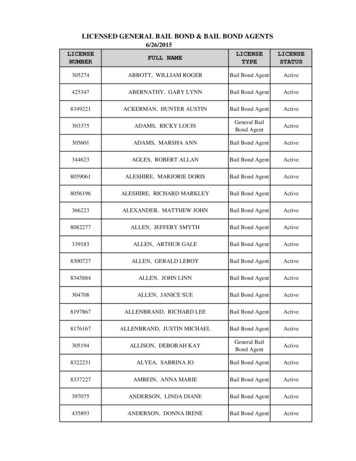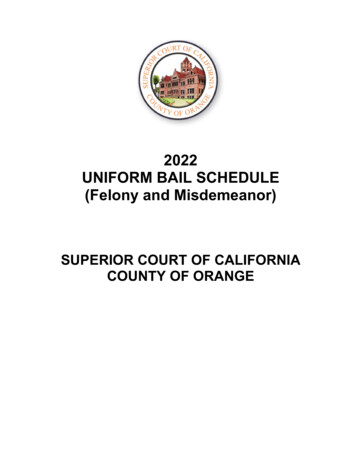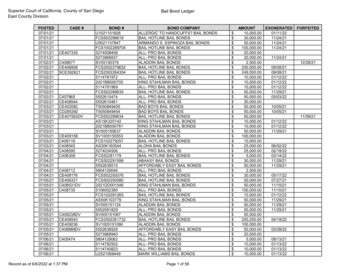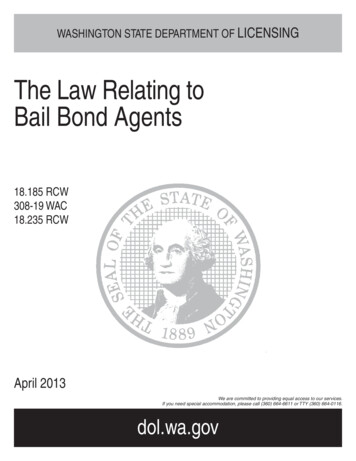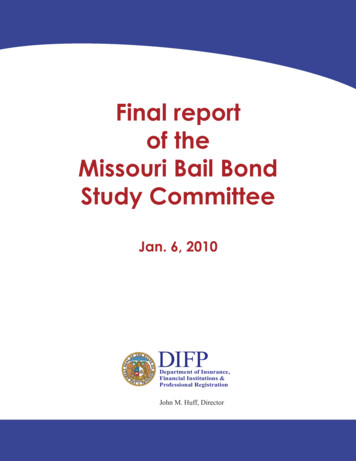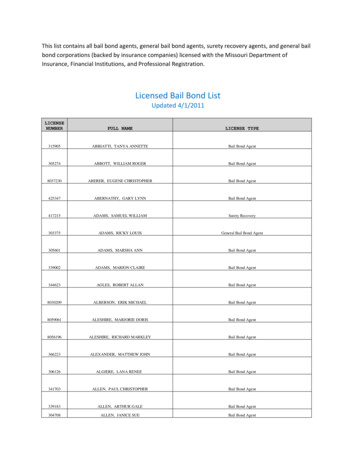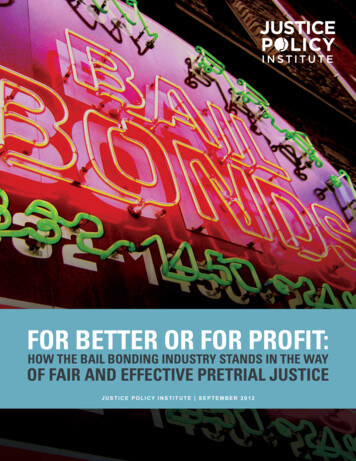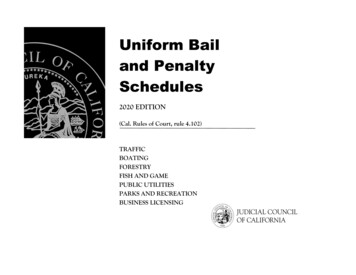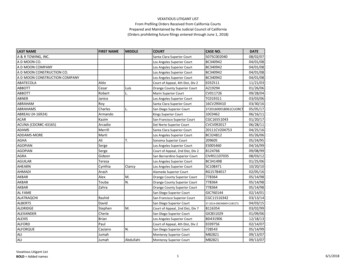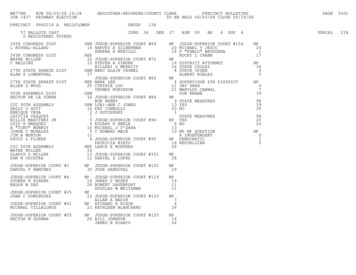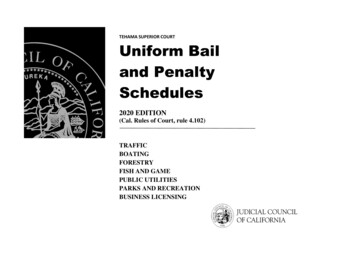
Transcription
TEHAMA SUPERIOR COURTUniform Bailand PenaltySchedules2020 EDITION(Cal. Rules of Court, rule 4.102)TRAFFICBOATINGFORESTRYFISH AND GAMEPUBLIC UTILITIESPARKS AND RECREATIONBUSINESS LICENSING
JUDICIAL COUNCIL OF CALIFORNIA455 Golden Gate AvenueSan Francisco, California 94102-3688Rule 4.102. UNIFORM BAIL AND PENALTY SCHEDULESTRAFFIC, BOATING, FORESTRY, FISH AND GAME,PUBLIC UTILITIES, PARKS AND RECREATION, BUSINESS LICENSINGThe Judicial Council of California has established the policy of promulgating uniform bail and penalty schedules for certainoffenses in order to achieve a standard of uniformity in the handling of these offenses.In general, bail is used to ensure the presence of the defendant before the court. Under Vehicle Code sections 40512 and 13103,bail may also be forfeited and such forfeiture may be ordered without the necessity of any further court proceedings and treated asa conviction for specified Vehicle Code offenses. A penalty in the form of a monetary sum is a fine imposed as all or a portion of asentence imposed.To achieve substantial uniformity of bail and penalties throughout the state in traffic, boating, fish and game, forestry, publicutilities, parks and recreation, and business licensing cases, the trial court judges, in performing their duty under Penal Codesection 1269b to annually revise and adopt a schedule of bail and penalties for all misdemeanor and infraction offenses exceptVehicle Code infractions, must give consideration to the Uniform Bail and Penalty Schedules approved by the Judicial Council.The Uniform Bail and Penalty Schedule for infraction violations of the Vehicle Code will be established by the Judicial Council inaccordance with Vehicle Code section 40310. Judges must give consideration to requiring additional bail for aggravating orenhancing factors.After a court adopts a countywide bail and penalty schedule, under Penal Code section 1269b, the court must, as soon aspracticable, mail a copy of the schedule to the Judicial Council with a report stating how the revised schedule differs from thecouncil’s uniform traffic bail and penalty schedule, uniform boating bail and penalty schedule, uniform fish and game bail andpenalty schedule, uniform forestry bail and penalty schedule, uniform public utilities bail and penalty schedule, uniform parks andrecreation bail and penalty schedule, or uniform business licensing bail and penalty schedule.b
The purpose of this uniform bail and penalty schedule is to:1. Show the standard amount for bail, which for Vehicle Code offenses may also be the amount utilized for a bailforfeiture instead of further proceedings; and2. Serve as a guideline for the imposition of a fine as all or a portion of the penalty for a first conviction of a listedoffense where a fine is used as all or a portion of the penalty for such offense. The amounts shown for themisdemeanors on the boating, fish and game, forestry, public utilities, parks and recreation, and business licensingbail and penalty schedules have been set with this dual purpose in mind.Unless otherwise shown, the maximum penalties for the listed offenses are six months in the county jail or a fine of 1,000, orboth. The penalty amounts are intended to be used to provide standard fine amounts for a first offense conviction of a violationshown where a fine is used as all or a portion of the sentence imposed.The bail amounts in the Uniform Bail and Penalty Schedules are calculated by using the maximum county and emergencymedical services penalty amount authorized by Government Code sections 76000 and 76000.5. When a court adopts acountywide bail schedule under Penal Code section 1269b for infraction offenses, the local schedule should be adjusted toreflect the specific penalty assessments that apply to a particular county under Government Code sections 76000 and 76000.5.If a court does not have night or weekend sessions for traffic cases, the countywide bail schedule should omit the 1 fee underVehicle Code section 42006. The Safety Enhancement–Double Fine Zone schedule applies only to specific counties asexpressly authorized by statute.Note: Courts may obtain copies of the Uniform Bail and Penalty Schedules by contacting:Judicial Council of CaliforniaCriminal Justice Services455 Golden Gate AvenueSan Francisco, California 94102-3688E-mail: TrafficAC@jud.ca.govwww.courts.ca.gov/7532.htmc
CONTENTSPREFACE . iiiI.II.III.IV.V.VI.VII.VIII.SECTION AND OFFENSE . iiiBASE BAIL . iiiADDITIONAL PENALTIES AND SURCHARGE . iiiTOTAL BAIL . ivBAIL CATEGORIES. viiiPOINT COUNT . viiiPRIOR CONVICTIONS . viiiTRAFFIC VIOLATOR SCHOOL . ixSample Calculation of Bail, Traffic Violator School Fee, and Court Operations Assessment for Multiple Offenses .xIX. LATE CHARGE .xSample Calculation of Late Penalty . xiX. OFFENSES ELIGIBLE FOR CORRECTION . xiXI. EVIDENCE OF FINANCIAL RESPONSIBILITY . xiiXII. PARKING VIOLATIONS . xiiTRAFFIC INFRACTION FIXED PENALTY SCHEDULE .1OVERWEIGHT CHART (PER VC 42030) .41WEIGHT CHART (PER VC 42030.1) . 42SPEED CHART . 43TRAFFIC MISDEMEANOR BAIL AND PENALTY SCHEDULE .44APPENDIX OF ENHANCED PENALTY AMOUNTS PER VEHICLE CODE SECTION 42009 .62VIOLATIONS COMMITTED IN HIGHWAY CONSTRUCTION OR MAINTENANCE AREA .62ENHANCED PENALTY SPEED CHART AMOUNTS PER VEHICLE CODE SECTION 42009 .72APPENDIX OF ENHANCED PENALTY AMOUNTS PER VEHICLE CODE SECTION 42010 .73VIOLATIONS COMMITTED IN SAFETY ENHANCEMENT–DOUBLE FINE ZONES . .73ENHANCED PENALTY SPEED CHART AMOUNTS PER VEHICLE CODE SECTION 42010 .81BOATING BAIL AND PENALTY SCHEDULE .82iFORESTRY BAIL AND PENALTY SCHEDULE .89FISH AND GAME BAIL AND PENALTY SCHEDULE .92PUBLIC UTILITIES BAIL AND PENALTY SCHEDULE .119i
PARKS AND RECREATION BAIL AND PENALTY SCHEDULE . .122SPEED CHART . .134BUSINESS LICENSING BAIL AND PENALTY SCHEDULE . . .135ii
PREFACEI. Section and OffenseA. Historically, only those offenses most often filed in municipal courts were included in the Uniform Bail and Penalty Schedules.Penal Code section 1269b and Vehicle Code section 40310 require the Judicial Council to establish a schedule for infractions ofthe Vehicle Code. The Judicial Council approved the first Traffic Infraction Bail and Penalty Schedule in November 1992.B. The letter “M” designates a misdemeanor: a crime punishable, at the discretion of the court, by imprisonment in a county jail for aperiod of no longer than 6 months or by a fine not exceeding 1,000 or by both (Penal Code section 19).C. The letter “I” designates an infraction: a violation of a law not punishable by imprisonment but by a fine generally not exceeding 100 for violations of the Vehicle Code (Vehicle Code section 42001) or 250 for violations of other codes (Penal Code section19.8(b)II. Base BailThe “Base Bail” indicated is the amount from which the “additional penalties” required by Penal Code section 1464; GovernmentCode sections 70372, 76000, 76104.6, and 76104.7; the surcharge required by Penal Code section 1465.7; and the penalty authorizedby Government Code section 76000.5 are calculated.III. Additional Penalties and Surchargeiii penalty required by Penal Code section 1464; state court constructionA. An “additional penalty” of between 22 and 27 ( 10 statepenalty of 5 required by Government Code section 70372(a); a county and state DNA Identification Fund penalty of 5 requiredby Government Code sections 76104.6 and 76104.7 (amended effective June 27, 2012); and a county penalty of up to 7 requiredby Government Code section 76000(e)) shall be levied upon every 10, or part of 10, of every fine, penalty, or forfeitureimposed and collected by the courts for criminal offenses. The “additional penalty” may increase by 2 for every 10, or part of 10, of the base fine if the county board of supervisors elects to levy an emergency medical services (EMS) penalty assessmentunder Government Code section 76000.5.B. Government Code section 70372(a) requires imposition of a state court construction penalty on every fine, penalty, orforfeiture collected by the courts for criminal offenses, including, but not limited to, all offenses, except parking offenses,as defined in Penal Code section 1463, involving violations of the Fish and Game Code and Vehicle Code or local ordinancesadopted pursuant to the Vehicle Code. Section 70372 specifies a state court construction penalty of 5 for every 10,or part of 10, of the criminal fine, penalty, or forfeiture.iii
C. Penal Code section 1464(b) provides that in the case of multiple offenses, the amount of “additional penalties” is to bedetermined by the total base bail or fine for all the offenses cited, and if the fine or base bail is suspended in whole or part,the “additional penalties” shall be reduced in proportion to the amount of suspension.D. Penal Code section 1465.7(a) requires imposition on criminal offenses of a state surcharge equal to 20 percent of the basefine used to calculate the state penalty assessment as specified in Penal Code section 1464(a). Penal Code section1465.7(b) requires that the surcharge be imposed in addition to the state penalty assessment pursuant to Penal Code section 1464and not be included in the base fine used to calculate the state penalty assessment as specified in section 1464. For the limitedpurpose of calculating the fee to attend traffic violator school under Vehicle Code section 42007, Penal Code section 1465.7(g)provides that the surcharge is excluded from the “Total Bail” amount used to determine the fee but is collected and distributedaccording to section 1465.7. The surcharge is part of the “Total Bail” in other circumstances, such as when a defendant requests atrial by written declaration or when a court permits payment of the “Total Bail” in installments.E. In counties with bonded indebtedness for court facilities, the count penalty assessment amount under Government Code section76000(e) is 7 for every 10 or part of 10 of the base fine. In counties without bonded indebtedness for court facilities, if thecounty penalty assessment amount listed in Government Code section 76000(e) is less than 7, the penalty for every 10, or part of 10, of the base fine is equal to the amount listed in Government Code section 76000(e) plus the amount obtained from multiplyingthe difference between 7 and the amount listed in Government Code section 76000(e) by the ratio of the square footage of courtfacilities transferred from the county to the state to the total court facility square footage in the county.F. Under Government Code section 76000.10(c)(1), a penalty of 4 for emergency medical air transportation (EMAT) services isimposed for every conviction of a violation of the Vehicle Code, or a local ordinance adopted under the Vehicle Code, committedon or after January 1, 2011. The assessment of this penalty is due to end on July 1, 2020. Penalties assessed before July 1, 2020shall continue to be collected, administered, and distributed pursuant to this section until exhausted or until December 31, 2021,whichever occurs first. This section will remain in effect only until July 1, 2022, when it will be repealed. (Assem. Bill 651; Stats.2019, ch. 537.)IV. Total BailA. Effective January 1, 1989, the Judicial Council adopted a “Total Bail” concept in an effort to obtain statewide consistency in the“bail” policies of the courts. The indicated “Total Bail” is for the first offense, and it must be followed to the extent required byPenal Code section 1269b.B. Except as otherwise required by statute, under Penal Code sections 1203, 1203.1, and 1203b, trial courts have discretion tosuspend the minimum sentence, including fines and penalties. For traffic cases, Vehicle Code section 42003 permits a judge or referee to considdefendant’s ability to pay. Vehicle Code section 42007 permits a judicial officer toreduce the fee to attend traffic violator school upon a showing that the defendant is unable to pay the full amount.Vehicle Code sections 42003 and 40510.5 permit installment payments of judgments in traffic cases, and Vehicle Codesection 42007 permits installment payments of the fee to attend traffic violator school.iv
ivC. Except for the following exceptions, counties must adhere to the Judicial Council’s Traffic Infraction Bail and PenaltySchedule for infraction violations of the Vehicle Code (Penal Code section 1269b and Vehicle Code section 40310).Penal Code section 1463.28 provides that 30 counties may exceed the “Total Bail” amounts of the Traffic InfractionBail and Penalty Schedule. Those counties are1. Alpine2. Amador3. Butte4. Calaveras5. Contra Costa6. Del Norte7. Fresno8. Humboldt9. Kings10. Lake11. Lassen12. Los Angeles13. Madera14. Mariposa15. Mendocino16. Modoc17. Mono18. Plumas19. San Benito20. San Diego21. San Joaquin22. Santa Clara23. Sierra24. Stanislaus25. Sutter26. Trinity27. Tulare28. Tuolumne29. Yolo30. YubaAdditional exceptions result from two pieces of legislation that became operative on January 1, 1994:1. Vehicle Code section 42001 allows local public entities that employ peace officers, universities, and state colleges to seta fine schedule for bicycle violations occurring in their jurisdictions that would supersede the Judicial Council penaltyschedule.2. Vehicle Code section 42009 requires that for any specified offense committed within a highway construction ormaintenance area during hours when work is being performed, the fine shall be double in the case of misdemeanors and in thecase of infractions shall be one category higher than otherwise provided in the Traffic Infraction Fixed Penalty Schedule. Anappendix with the specified offenses listed and the enhanced amounts follows the Traffic portion of the bail and penaltyschedules, starting on page 61.3. Streets and Highways Code section 97 provides for increased fines for a safety enhancement–double fine zone on the segmentof Route 12 between the Route 80 junction in Solano County and the Route 5 junction in San Joaquin County.v
Under section 97, the base fine for any specified offense committed in the safety enhancement–double fine zone shall bedouble in the case of misdemeanors and in the case of infractions shall be one category higher than otherwise providedin the Uniform Bail and Penalty Schedules. Any additional penalty, forfeiture, or assessment imposed by any otherstatute shall be based on the amount of the base fine before enhancement or doubling and shall not be based on theamount of the enhanced fine.The “Categories” indicated in the Traffic Infraction Bail and Penalty Schedule under Vehicle Code sections 40310,42009(a), and 42010 will be shown as “1a” and “1b,” “2a” and “2b,” “3a” and “3b,” and “4a” and “4b,” with the “b”subcategory referring to the violation when it is committed in a highway construction zone or safety enhancement–double fine zone.D.The “Total Bail” amounts within the Uniform Boating, Forestry, Fish and Game, Public Utilities, Parks and Recreation, andBusiness Licensing Bail Schedules are suggested amounts, and their adoption by courts is not compulsory.E.The “Total Bail” amount indicated includes the base bail and those “additional penalties” required by Penal Code section1464 and Government Code sections 70372, 76000, 76104.6, and 76104.7, and the 20 percent surcharge on the base bailrequired by Penal Code section 1465.7, except as provided in Vehicle Code section 42007. When authorized by the countyboard of supervisors, the “Total Bail” for a countywide bail schedule adopted under Penal Code section 1269b may alsoinclude an additional 2 penalty under Government Code section 76000.5 for every 10, or part of 10, of the base fine.Assessments adopted by a court—such as under Vehicle Code section 40508.6—shall be collected in addition to the “TotalBail.” The court operations assessment imposed per convicted offense under Penal Code section 1465.8; assessment fornight court under Vehicle Code section 42006; traffic assistance program (TAP) fee under Vehicle Code section 11205.2;and criminal conviction assessment under Government Code section 70373 are collected as part of the “Total Bail,” but arenot subject to the special distribution for the “Total Bail” in traffic violator school cases under Vehicle Code section 42007.For every conviction of a violation of the Vehicle Code, or ordinance adopted under the Vehicle Code, committed on orafter January 1, 2011, a 4 EMAT penalty is imposed under Government Code section 76000.10(c)(1) as part of the “TotalBail.” Effective January 1, 2014, Penal Code section 1202.4(b)(1) requires a minimum 150 restitution fine as anassessment in addition to the “Total Bail” in every case where there is a misdemeanor conviction. Other mandatoryassessments may also be applicable, especially in DUI cases.Fish and Game Code section 12021 authorized a 15 penalty to be collected in addition to the fine and penalties normallycollected for violations of the Fish and Game Code, to be deposited in the Fish and Game Preservation Fund and disbursedas specified. The 15 additional penalty does not apply to violations punishable pursuant to Fish and Game Code section12002.1(b) or 12002.2(b) or to any regulation relating to the wearing or display of a fishing license.vi
F. “Total Bail” shall not exceed statutory limits. Vehicle Code section 40310 specifies that the “fine” amount of the total bail shall not exceedthe limitations specified by Vehicle Code sections 42001 and 42001.5.G. Rule 4.105 of the California Rules of Court provides that with certain exceptions deposit of bail is not required to appear for arraignment ortrial for an infraction case. Deposit may be required: by statute, such as trial by written declaration; if a person does not sign a promise toappear as ordered by the court; or a judicial officer states a reason for a deposit to schedule a trial.In cases where a court appearance is required by a court, the amounts set forth in the Uniform Bail and PenaltySchedules do not necessarily indicate the appropriate total penalties; rather, they ensure that, in most cases, when bail is posted, sufficientfunds will be available to meet the defendant’s obligations. Upon conviction, however, “additional penalties” are added to any fine. It isincumbent upon the judge who hears each case to determine the proper total penalty (fine and “additional penalties”) based on the particularfacts presented.With the exception of juveniles under age 18, there shall be no mandatory court appearance for any infraction of theCalifornia Vehicle Code punishable by fine only. A court may require a mandatory appearance for an infraction violation of the VehicleCode when a statutory driver’s license restriction, suspension, or revocation is authorized; community service or proof of payment orcorrection is mandatory; or a violation requires specific action under the Vehicle Code in addition to a fine. This paragraph does not apply toviolations of local ordinances based on Vehicle Code sections.H. The “Total Bail” for an offense not specifically listed in the Uniform Traffic Infraction Bail and Penalty Schedule is the amount set for thegeneral category of that offense unless a California code or regulation specifies otherwise. The court operations assessment and criminalconviction assessment are collected in addition to the “Total Bail.” The suggested minimum “Total Bail” for an offense not specifically listedin the Uniform Traffic Misdemeanor Bail and Penalty Schedule, unless a California code or regulation specifies otherwise, is:Base Additional Penalties*& SurchargeMisdemeanor 75 251Infraction 35 127 Fees 70 75 Total Bail*/Fees (*See sections II–IV) 396 237The suggested minimum “Total Bail” for an offense not specifically listed in the Uniform Public Utilities Bail andPenalty Schedule, unless a California code or regulation specifies otherwise, is:Misdemeanor 185 588 70 843The suggested minimum “Total Bail” for an offense not specifically listed in the Uniform Boating, Business Licensing,Fish and Game, Forestry, or Parks and Recreation Bail and Penalty Schedules, unless a California code or regulationspecifies otherwise, is:Misdemeanor 100Infraction 35 310 123 vii 70 75 480 233
V.Bail CategoriesAssembly Bill 1344 (Stats. 1992, ch. 696), effective September 15, 1992, amended Vehicle Code section 40310 to classify Vehicle Code offensesinto four or fewer penalty categories, according to the severity of the offenses. The Judicial Council has approved the following categories ofbail/fine after considering suggestions from its Traffic Advisory Committee and the recommendations made by the National Center for StateCourts:Category 1Category 2Category 3Category 4Base Additional SurTotal(*See secs. II–IV)Fine Penalties* & charge Fees Bail* /Fees 25 96 75 196Bicyclist, motorized scooter, pedestrian,pocket bike, vehicle registrationand equipment offensesDriver’s license, operation of vehicle, 35 127 75 237and size and load offensesSubstance abuse infractions, VC 2818, 70 221 75 366VC 20004, VC 21706.5, and VC 27375Miscellaneous offenses for which the penalties or the fee for dismissal with proof of correction are specificallyset by the Vehicle Code, speeding offenses (refer to Speed Chart), and infractions pursuant to PC 19.8If a citation does not indicate that an offense is eligible for correction under Vehicle Code 40522, a court may presume that the offense is cited asnoncorrectable. (See also California Highway Patrol v. Superior Court (2008) 158 Cal.App.4th 726, 740.) Vehicle Code section 14610.5(a) maybe charged as either an infraction or a misdemeanor (Vehicle Code section 14610.5(b)). Penal Code section 19.8 lists the following offenses thatare an infraction with a fine of up to 250: Vehicle Code sections 5201.1, 12500(a), 14601.1, 23109(c), 27150.1, 40508, and 42005. If one ofthese offenses is charged as an infraction, the appropriate penalty is listed in the Traffic Infraction Bail and Penalty Schedule. If the offense ischarged as a misdemeanor, the recommended penalty is listed in the Traffic Misdemeanor Bail and Penalty Schedule.VI. Point CountVehicle Code sections 12810, 12810.2, 12810.3, and 12810.4 determine the amount of point count. The Department of Motor Vehiclesestablishes conviction point count based on statutory guidance and definition. Vehicle Code section 12810.5 defines a “negligent operator” basedon point count. The Department of Motor Vehicles may take an administrative sanction against a person’s driving privilege based on “points”(Vehicle Code section 12810.5).VII. Prior ConvictionsA. The base fine for one Vehicle Code moving violation that is assessed “points” on a current arrest or citation may beenhanced by 10 for each “prior” conviction within 36 months of the new alleged offense. For calculating the enhancement, both the currentand “prior” offense must be a moving violation for which a “point” has been assigned per Vehicle Code section 12810 or 12810.2. Aconfidential conviction after completion of traffic violator school is not assigned a point or counted as a prior offense for purposes ofenhancing the fine of a subsequent offense. Regardless of the number of moving violation convictions on a citation, only one “prior” percitation shall be counted in determining the enhancement on the current offense.viii
While Vehicle Code section 42001 references maximum fines within a one-year time frame, the Judicial Council hasinterpreted section 42001 to not preclude a court from considering “prior” convictions for a longer period of time. Theperiod of 36 months was adopted by the Judicial Council (effective January 1, 1989) to correspond to and reinforce Vehicle Code sections12810 and 12810.5. These sections define the “point system” used by the Department of Motor Vehicles as prima facie evidence of thenegligent operation of a motor vehicle.Vehicle Code sections 15306 and 15308 specify penalties for commercial drivers in terms of subsequent offenses occurring within threeyears.B. In the case of an owner responsibility citation, the “prior” must relate to the particular vehicle for which the new offense is charged.C. Vehicle Code section 42004 provides that the court, in determining a penalty to be imposed pursuant to the Vehicle Code, may use a writtenreport from the Department of Motor Vehicles that contains information showing prior convictions.D. With the exception of parking, pedestrian, and bicycle offenses on a current citation, Vehicle Code section 40508.6 authorizes courts toestablish an administrative assessment, not to exceed 10, for the purpose of recording and maintaining a record of a defendant’s priorconvictions, that is payable at the time of payment of a fine or when bail is forfeited for any subsequent violation.VIII. Traffic Violator SchoolA. Vehicle Code section 42007 provides that:1. The court shall collect a fee from every person ordered or permitted to attend traffic violator school in an amount equal to the total bailset forth for the eligible offense in the uniform countywide bail schedule;2. Where multiple offenses are charged on a single notice to appear, the “total bail” amount collected is the amount applicable to the greaterof the eligible offenses; and3. The court may set a lesser fee upon a showing that the defendant is unable to pay the full amount.B. Vehicle Code section 40512.6 provides that the fee may be converted to bail and forfeited if the defendant fails to submit proof of schoolcompletion within the time ordered by the court.C. Vehicle Code section 42007.1(a) provides that a 49 fee, a fee for monitoring traffic violator schools, and a TAP fee under Vehicle Codesection 11205.2(c) are to be added to the “total bail” of the offense eligible for traffic violator school.D. Vehicle Code section 42005 prohibits drivers of commercial vehicles from eligibility for traffic violator school. Driversix
with a Class A, Class B, or commercial Class C driver’s license may attend traffic violator school to avoid points for traffic violations in avehicle that requires only a class M or noncommercial class C license. Vehicle Code section 42005(d) excludes violations of Vehicle Codesections 20001, 20002, 231
bail and penalty schedules have been set with this dual purpose in mind. Unless otherwise shown, the maximum penalties for the listed offenses are six months in the county jail or a fine of 1,000, or both. The penalty amounts are intended to be used to provide standard fine amounts for a first offense conviction of a violat ion
